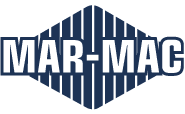Those who know and have used MAR-MAC Industries, Inc.’s products, know that our products aren’t “just” anything. Behind one roll of coil wire is over 65 years of science, innovation, connections, and relationships. And we always strive to improve.
The process of making tie wire matters and is what sets us apart from the competition and import wire. Whether that’s the quality of our wire rod, the temperature it’s annealed at, or the machines that make the coils, and the hands that package each box: every detail is important.
There are many wire properties that are monitored to assure that your tie wire product meets the expectations of MAR-MAC, the buyer, the end-user, and the job requirements. Some of those properties are the wire gauge, wire cleanliness, tensile (wire hardness), coil dimension, and coil performance.
Your tie wire’s processing begins with assuring the gauge requirements are met. The wire is drawn down from wire rod to specified gauge tolerances that are measured as fine as one ten thousandths of an inch. The gauge size is determined by industry standards and the tolerances used to comply with ASTM standards. If the wire is larger than the gauge specification, then you get fewer feet per coil and less productivity. If the wire diameter is smaller than the gauge specification, then there is a loss in break load strength and it may not meet the job strength requirements.
The next controlled property of the wire is the tensile strength which is related to the hardness or pliability of the wire. The tensile strength is determined by the chemistry of the wire and the annealing process. The drawn wire is batch annealed in a furnace or several furnaces depending on the amount of wire processed. One furnace load can contain up to 16 tons of wire product. The wire is “baked” according to electronically controlled “recipes”. In the case of tie wire, the wire is “dead soft” annealed to assure the wire is as soft and pliable as possible which will make the wire easy to twist and cut. There are differing “recipes” that determine the length of the annealing cycles for different types of wire.
Once the wire leaves the annealing process and is cooled, then the wire is coiled or wound in our coiling operation. The machines in this operation are designed to assure the proper coil dimensions and coil properties to assure they work properly on the job site. The coils are wound and tied in this operation utilizing controls to assure an even pattern in the coil so the wire does not tangle resulting in smooth operation when the wire is pulled from the reel. Final coil dimensions are determined by the machine design, machine controls, and are verified to ensure a good coil fit in the reel.
We assure our tie wire is protected from corrosion after it leaves our plant, is shipped, stored, and then shipped again to the jobsite by applying a rust preventative dissipating oil to the wire during the coiling process. Since it is a dissipating oil, over time the coils will appear dry but the rust preventative component is left on the wire. This means that when you open a box of MAR-MAC wire on the job that your wire looks the same as when it left us.
